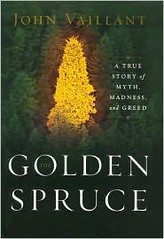
PREV ARTICLE
NEXT ARTICLE
FULL ISSUE
PREV FULL ISSUE
WHY WERE THE PINE, OAK, AND WILLOW TREES DEPICTED ON U.S. COLONIAL COINS? Dave Kellogg submitted these thoughts about a numismatic passage he found in an obscure place - a book about the logging industry. -Editor  Readers of Yeoman's Red Book will be familiar with the origins of coinage in America, and they might enjoy reading the following passage from John Vaillant's excellent book, The Golden Spruce. Readers of Yeoman's Red Book will be familiar with the origins of coinage in America, and they might enjoy reading the following passage from John Vaillant's excellent book, The Golden Spruce. As the book's cover states, The Golden Spruce is a "story of myth, madness and greed" in the Pacific Northwest, covering the feverish cutting of trees for use in 18th/19th century ships. Eastern trees and later the giants of the northwest were so valuable that sailors would travel sometimes half-way around the world to bring back as much of the "tall, straight and knot-free timber" as the ships could carry.  Here's the passage: Here's the passage: In 1652, after decades of using a motley assortment of currencies, ranging from Indian wampum to tobacco and Spanish silver, the Massachusetts Bay Colony began minting its own money. These crude coins were not decorated with crosses, kings, or familiar symbols of liberty, they were embossed with trees, specifically, pine, oak, and willow. "What better way to portray the wealth of our country?" wrote the coins' die maker, Joseph Jenks. I wonder where this Joseph Jenks quote comes from - has anyone seen this before? Dave tells me "The author cites Sloane, 75. and Sloane, Eric. A Reverence for Wood. New York, 1965." Not much is known about Jenks, and apparently the only reference to his connection to the Massachusetts coinage is a mention in a history of the Saugus Iron works. -Editor From the University of Notre Dame web site: We do not know who made the punches and dies used in the minting of these coins but they are frequently attributed to master ironsmith, Joseph Jenks, Sr. of Hammersmith, the first iron foundry in the colonies, in what is now Saugus, Massachusetts. For more information on Joseph Jenks, see: Joseph Jenks (www.coins.nd.edu/ColCoin/ColCoinIntros/MASilver.Jenks.intro.html) Wayne Homren, Editor The Numismatic Bibliomania Society is a non-profit organization promoting numismatic literature. See our web site at coinbooks.org. To submit items for publication in The E-Sylum, write to the Editor at this address: whomren@gmail.com To subscribe go to: https://my.binhost.com/lists/listinfo/esylum All Rights Reserved. NBS Home Page Contact the NBS webmaster 
|